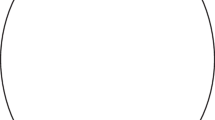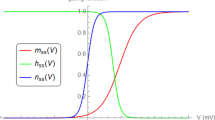Abstract
It was shown by means of a mathematical model of a myelinated nerve fiber (Frankenhaeuser — Huxley) that an increase in threshold and decrease in the amplitude of the action potential (AP) during the relative refractory period are due mainly to sodium inactivation. The contribution of increased potassium permeability to these changes is small, for the chief component of the outgoing ionic current in the node of Ranvier is not the potassium current, but the leak current. Given the ratio between these currents the increase in threshold and graduation of the action potential in the node membrane are less marked than in the membrane of the squid giant axon. At the beginning of the relative refractory period the AP evoked by strong stimulation is conducted only to the next node. Later in the refractory period impulses are conducted incrementally, and the threshold for the spreading impulse is higher than the threshold for spike excitation in the stimulated node. Delay in impulse conduction between refractory nodes leads to the formation of a retrograde depolarization wave. The reasons for differences in the mechanisms of impulse conduction along unmyelinated and myelinated refractory fibers are discussed.
Similar content being viewed by others
Literature cited
M. B. Berkinblit, Propagation of Impulses in a Unidimensional Excitable Medium. Author's Abstract of Dissertation [in Russian], Pushchino (1969).
M. B. Berkinblit, "Periodic blocking of impulses in excitable tissues," in: Models of the Structural and Functional Organization of Certain Biological Systems [in Russian], Nauka, Moscow (1966), pp. 131–158.
M. L. Bykhovskii, A. D. Korotkov, A. M. Rusanov, and B. I. Khodorov, "Investigations on a mathematical model of the dependence of action potential parameters on the velocity constants of sodium membrane permeability," Biofizika,12, 529 (1967).
I. M. Gel'fand and M. L. Tsetlin, "Continuous models of control systems," Dokl. Akad. Nauk SSSR,131, 1242 (1960).
I. Tasaki, Conduction of the Nervous Impulse [Russian translation], IL, Moscow (1957).
E. N. Timin and B. I. Khodorov, "Analysis of the mechanisms of conduction of nervous impulses in the relative refractory period on a mathematical model of the squid giant axon," Neirofiziologiya,3, 434 (1971).
B. I. Khodorov and E. N. Timin, "Theoretical analysis of the mechanisms of impulse conduction along a nonuniform fiber. III. Transformation of rhythms in a cooled segment of fiber," Biofizika,15, 503 (1970).
B. I. Khodorov and E. N. Timin, "Theoretical analysis of mechanisms of impulse conduction along the myelinated fiber during a functional change in the properties of single nodes," Neirofiziologiya,3, 316 (1971).
K. Cole and H. Curtis, "Electric impedance of the squid giant axon during activity," J. Gen. Physiol.,22, 649 (1939).
F. Dodge, "Ionic permeability changes underlying nerve excitation," in: Biophysics of Physiological and Pharmacological Action (1961), pp. 119–142.
R. FitzHugh, "Computation of impulse initiation and saltatory conduction in myelinated nerve fiber," Biophys. J.,2, 11 (1962).
B. Frankenhaeuser and A. Huxley, "The action potential in the myelinated nerve fibre ofXenopus laevis as computed on the basis of voltage clamp data," J. Physiol. (London),171, 302 (1964).
L. Goldman and J. Albus, "Computation of impulse conduction in myelinated fiber; theoretical basis of velocity-diameter relation," Biophys. J.,8, 596 (1968).
A. Hodgkin, "The subthreshold potentials in crustacean nerve fiber," Proc. Roy. Soc., B,126, 87 (1938).
H. Meves, "Die Nachpotentiale isolierter markhaltiger Nervenfasern des Frosches bei Einzelreizung," Pflüg. Arch. Ges. Physiol.,271, 655 (1960).
R. Nonner and R. Stämpfli, "A new voltage clamp method," in: Laboratory Techniques in Membrane Biophysics, Springer, Berlin (1969), pp. 171–175.
I. Tasaki and W. Freygang, "The parallelism between the action potential, action current, and membrane resistance at the node of Ranvier," J. Gen. Physiol.,39, 211 (1955).
Additional information
Vishnevskii Institute of Surgery, Academy of Medical Sciences of the USSR, Moscow. Translated from Neirofiziologiya, Vol. 4, No. 2, pp. 201–207, March–April, 1972.
Rights and permissions
About this article
Cite this article
Khodorov, B.I., Timin, E.N. & Grilikhes, R.I. A mathematical model of a myelinated nerve fiber for analysis of impulse conduction mechanisms during the relative refractory period. Neurophysiology 4, 152–157 (1972). https://doi.org/10.1007/BF01063421
Received:
Issue Date:
DOI: https://doi.org/10.1007/BF01063421




